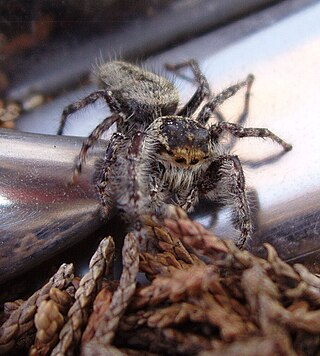
Huntsman spiders, members of the family Sparassidae, are known by this name because of their speed and mode of hunting. They are also called giant crab spiders because of their size and appearance. Larger species sometimes are referred to as wood spiders, because of their preference for woody places. In southern Africa the genus Palystes are known as rain spiders or lizard-eating spiders. Commonly, they are confused with baboon spiders from the Mygalomorphae infraorder, which are not closely related.

The Araneomorphae are an infraorder of spiders. They are distinguishable by chelicerae (fangs) that point diagonally forward and cross in a pinching action, in contrast to the Mygalomorphae, where they point straight down. Araneomorphs comprise the vast majority of living spiders.

Ctenizidae is a small family of mygalomorph spiders that construct burrows with a cork-like trapdoor made of soil, vegetation, and silk. They may be called trapdoor spiders, as are other, similar species, such as those of the families Liphistiidae, Barychelidae, and Cyrtaucheniidae, and some species in the Idiopidae and Nemesiidae. The name comes from the distinctive behavior of the spiders to construct trapdoors, and ambush prey from beneath them.

The Pholcidae are a family of araneomorph spiders. The family contains more than 1,800 individual species of pholcids, including those commonly known as cellar spider, daddy long-legs spider, carpenter spider, daddy long-legger, vibrating spider, gyrating spider, long daddy, and skull spider. The family, first described by Carl Ludwig Koch in 1850, is divided into 94 genera.

Ground spiders comprise Gnaphosidae, the seventh largest spider family with over 2,000 described species in over 100 genera distributed worldwide. There are 105 species known to central Europe, and common genera include Gnaphosa, Drassodes, Micaria, Cesonia, Zelotes and many others. They are closely related to Clubionidae. At present, no ground spiders are known to be seriously venomous to humans.

Selenopidae, also called wall crab spiders, wall spiders and flatties, is a family of araneomorph spiders first described by Eugène Simon in 1897. It contains over 280 species in nine genera, of which Selenops is the most well-known. This family is just one of several families whose English name includes the phrase "crab spider". These spiders are often called "Flatties" due to their flattened dorsal profile. The Afrikaans name for these spiders is "Muurspinnekop," which translates directly to "wall spider."
Benoy Krishna Tikader (1928–1994) was an Indian arachnologist and zoologist and a leading expert on Indian spiders in his time. He worked in the Zoological Survey of India and published the Handbook of Indian Spiders in 1987. The book describes 40 families and 1066 species of India, many of which were described by Tikader himself. The handbook is a guide to all arachnids including scorpions, and not just spiders. He was also a popular scientific author in his native language of Bengali, and was the author of Banglar Makorsha for the layman.

Antrodiaetidae, also known as folding trapdoor spiders or folding-door spiders, is a small spider family related to atypical tarantulas. They are found almost exclusively in the western and midwestern United States, from California to Washington and east to the Appalachian mountains. Exceptions include Antrodiaetus roretzi and Antrodiaetus yesoensis, which are endemic to Japan and are considered relict species. It is likely that two separate vicariance events led to the evolution of these two species.

Drassodes is a genus of ground spiders that was first described by Niklas Westring in 1851. They are brown, gray, and red spiders that live under rocks or bark in mostly dry habitats, and are generally 3.8 to 11.6 millimetres long, but can reach up to 20 millimetres (0.79 in) in length.

Alopecurus saccatus is a species of grass known by the common name Pacific foxtail, or Pacific meadow foxtail.
Cryptocheilus notatus is the largest species of spider wasps (Pompilidae) to be found in Great Britain reaching up to 18 mm in length.
Litopyllus is a genus of ground spiders that was first described by R. V. Chamberlin in 1922. As of May 2019 it contains only three species: L. cubanus, L. realisticus, and L. temporarius.
Sidydrassus is a genus of ground spiders that was first described by S. L. Esyunin & T. K. Tuneva in 2002. As of May 2019 it contains only three species: S. rogue, S. shumakovi, and S. tianschanicus.
Pardosa hyperborea is a species of wolf spiders in the family Lycosidae. It is found in North America, Greenland, Europe, and Russia.

Phidippus asotus is a species of jumping spiders in the family Salticidae. It is found in the United States and Mexico.

Segestria pacifica is a species of tube web spiders in the family Segestriidae. It is found in the USA.
Drassodes gosiutus is a species of ground spider in the family Gnaphosidae. It is found in the USA and Canada.
Omias saccatus, the sagebrush weevil, is a species of broad-nosed weevil in the beetle family Curculionidae. It is found in North America.











